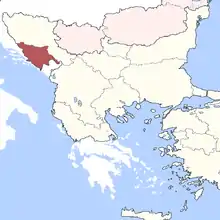Herzegovina Eyalet
The Eyalet of Herzegovina (Ottoman Turkish: ایالت هرسك; Eyālet-i Hersek,[1] Serbo-Croatian: Hercegovački pašaluk) was an Ottoman eyalet from 1833 to 1851. Its last capital was Mostar.
| Eyālet-i Hersek | |||||||||
|---|---|---|---|---|---|---|---|---|---|
| Eyalet of the Ottoman Empire | |||||||||
| 1833–1851 | |||||||||
 Flag | |||||||||
 The Herzegovina Eyalet in the 1850s | |||||||||
| Capital | Mostar | ||||||||
| Demonym | Herzegovinians | ||||||||
| Area | |||||||||
| • Coordinates | 43°20′N 17°48′E | ||||||||
| Government | |||||||||
| Pasha | |||||||||
• 1833–51 | Ali-paša Rizvanbegović | ||||||||
| History | |||||||||
• Established | 1833 | ||||||||
• Disestablished | 1851 | ||||||||
| |||||||||
| Today part of | |||||||||
History
In 1831, Bosnian kapudan Husein Gradaščević occupied Travnik, demanding autonomy and the end of military reforms in Bosnia.[2] Ultimately, exploiting the rivalries between beys and kapudans, the grand vizier succeeded in detaching the Herzegovinian forces, led by Ali-paša Rizvanbegović, from Gradaščević’s.[2] The revolt was crushed, and in 1833, a new eyalet of Herzegovina was created from the southern part of the eyalet of Bosnia and given to Ali Agha Rizvanbegović as a reward for his contribution in crushing the uprising.[2] This new entity lasted only for 18 years, that is, for the rest of Rizvanbegović's life: he was executed when the Porte discovered he was secretly building an independent power base. After Rizvanbegović's death, it was reintegrated into the Bosnia eyalet.
Administrative divisions
The Pashaluk of Herzegovina was formed from following counties: Prijepolje, Pljevlja with Kolašin and Šaranci with Drobnjak, Čajniče, Nevesinje, Nikšić, Ljubinje-Trebinje, Stolac, Počitelj, Blagaj, Mostar, Duvno and half of the county of Konjic which is on southern side of Neretva.
References
- "Some Provinces of the Ottoman Empire". Geonames.de. Archived from the original on 27 August 2013. Retrieved 25 February 2013.
- Gábor Ágoston; Bruce Alan Masters (2009-01-01). Encyclopedia of the Ottoman Empire. Infobase Publishing. p. 91. ISBN 978-1-4381-1025-7. Retrieved 2013-05-20.
- Dr. Lazar Tomanović, Petar Drugi Petrović, Njegoš kao vladalac, Državna Stamparija (1896).